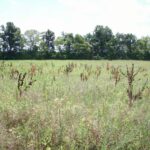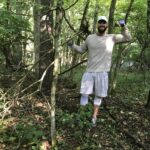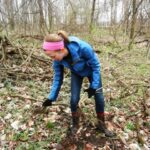By Chris Roshon, Natural Resources Manager
It’s National Invasive Species Awareness Week, May 16 – 23. The United States Department of Agriculture defines invasive species as: 1) non-native (or alien) to the ecosystem under consideration and 2) whose introduction causes or is likely to cause economic or environmental harm or harm to human health. Invasive species in our area include several species of insects, reptiles, plants, birds, and fungus.

As someone with personal and professional interest in removing invasive plants from the park district, I would like to take this opportunity to highlight some of the work that has been done lately.
Each summer, a small crew of staff battles invasive plants in the parks. Recently created wetlands are combed through for narrow-leaved cattail, reed canary grass, and phragmites. Former fields that have been planted with native seedlings are relieved of bush honeysuckle, callery pear, and autumn olive. High quality sites with just a few invasive plants that can be removed efficiently are also given some attention.

The goal of most of this work is to keep non-natives out long enough to allow native populations to become established. Once natives are established, it is much less likely that invasives will become dominant in the future. We cannot keep invasives out of all areas of our parks, but with effort and persistence we are getting results where we have been able to work. It has been rewarding to see invasive plant populations reduced in areas that have been managed for multiple years.
Volunteers are getting serious invasive removal work done in our parks, too. Most volunteers are focusing on species that can be pulled directly out of the ground such as garlic mustard and honeysuckle. Some volunteers opt to move around and visit multiple sites, others are focused on thorough eradication in specific areas.

Thank You to all the individuals who have made our parks a little more native over the years, and to anyone who may be willing to give native species a boost in the future.






